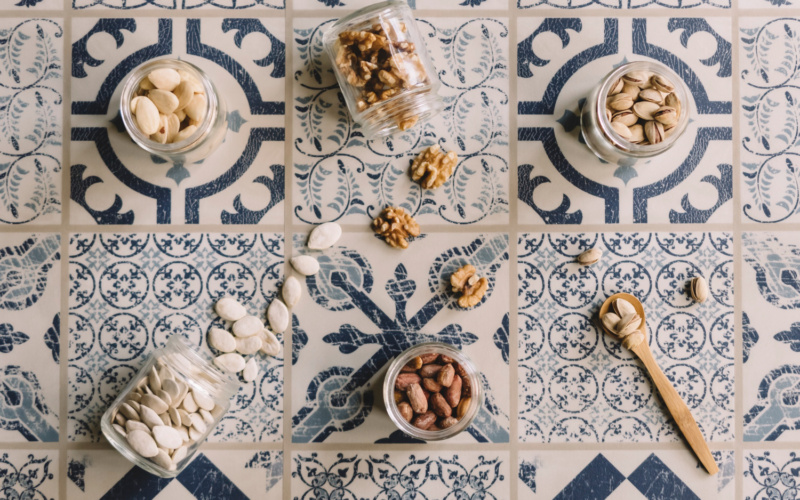Delft Tile Inspiration and Tile Production
Delft tile inspiration come from the city of Delft, situated between Rotterdam and The Hague, the Dutch city of Delft has a long political history through its association with the House of Orange and significant cultural past. That wonderful past is amply evidenced by the great painter, Johannes Vermeer, noted for “Girl with a Pearl Earring” below and “View of Delft”, shown at the top of this post.
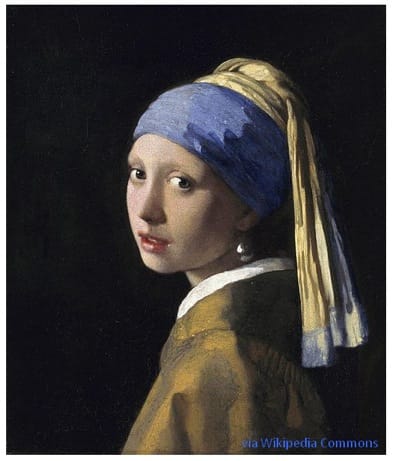
However, we are a stone, tile, and glass site, so let’s drill down on the legendary Delftware and in particular Delft tiles inspiration. The omniscient Wikipedia defines Delftware as “blue and white pottery made in and around Delft in the Netherlands and the tin-glazed pottery made in the Netherlands from the 16th century.
Delftware in the latter sense is a type of pottery in which a white glaze is applied, usually decorated with metal oxides. Delftware includes pottery objects of all descriptions such as plates, ornaments, and tiles”. Below, you can see a classic bit of Delftware from the Pushkin Museum.
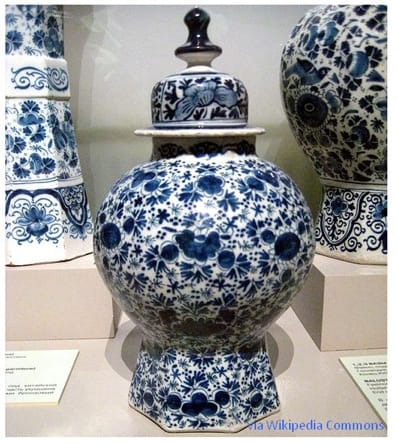
Original Delft tile inspirations were old European themes such as hunting, fishing, children, and various sports. Some of the animals or children’s paintings are truly unique. Small sails and animals were painted in traditional tile size of 5 1/2″x 5 1/2″. These tiles were used by themselves or inserted in a sea of Dutch white tile, or antiqued white tile. Elaborately painted of everyday themes, these tiles were used in farmhouses, churches, Palaces, and many other places. Tiles were used in fireplace surrounds, kitchen tile areas, and bathrooms.
In the America of the 21st Century, Delft tile inspiration is most commonly thought of, in the broadest layman’s terms, as simply a white tile with blue decorative elements. But as depicted below, one should always expect a hand-finished artisan style with crazing or minute cracks in the glaze.
>
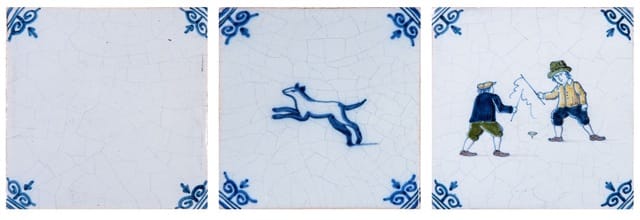
At Country Floors, we have enjoyed a long relationship with a Dutch producer of Delft tiles located in Makkum. This is reflected in our authentically beautiful Royal Makkum Collection.
As you review this Delft selection, you will notice all the classic genre elements: white background, blue ornamentation, country ambiance, and farm scenes. This tile factory is literally the oldest tile factory in the World. Survivors of this factory have been operating since the 15th century.
A great example of this is the farmhouse below in Bedford, New Hampshire by LKM Designs. If you are seeking to realize your kitchen tile ideas through the placement of Delft tiles, look no further than this classic usage.
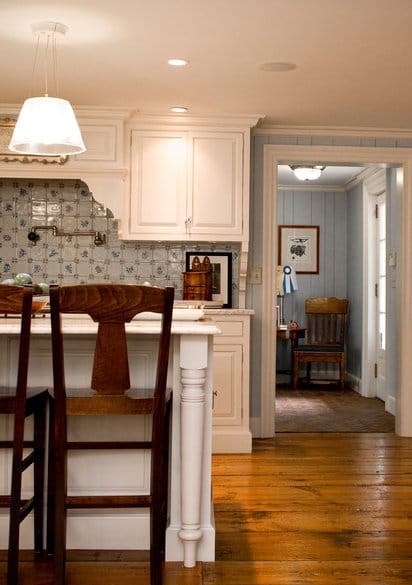
Here is a final suggestion. Consider bringing samples of other elements that you may want to “work” with your Delft tile. For example paint chips, fabric swatches, millwork samples, etc. etc.
This may sound obvious but you would be amazed at how many clients leave these things at home. In fact, these tiles are so beautiful many people use them as coasters or keep them as a souvenir.
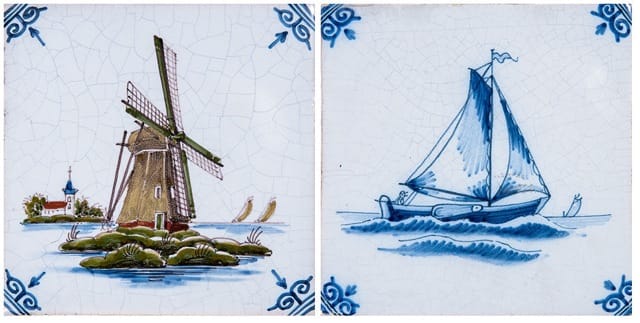
White tile, or the Dutch Delft white tile, or antique white as known by many times is a true tile beauty. Due to glaze colors and 5 centuries of tile making, the Dutch white is one of the most beautiful tiles in the World.
Tiles are hand-pressed, therefore they are not perfect and this irregularity provides a unique hand made tile. These are tiles are hand sprayed and when you look a field of white tiles you will see a natural variation and a wonderful beauty.
Delft blue or blue and white tile is also another timeless masterpiece. Many Delft tiles have various shades of blue in the background. These tiles can be crackled or normal. Crackled tile is another form of tile production challenge. Glazes on these tiles react to a mismatch between the glaze contraction and its ceramic body. A truly crackled tile can literally crackle for the rest of its time. This provides timeless beauty.
Another common use of these tiles is to use them as forms of art. Murals for an entire wall or framed murals with old European castles, palaces, or artisan themes are found in many houses. These tiles are commissioned so that an entire mural is handpainted to a field of tiles.
These tiles consist of small size like 4×4 o5 5×5 tiles and when installed they show a piece of art. Some artisans frame these murals with moldings that frame the piece of art.
Modern-day production:
Due to the difficulty in finding true painters for tile, Country Floors introduced the Delft Ceramic Tiles Collection. This collection curates the best sellers of Delft tiles and these lines are produced in modern reproduction lines. Our factory produces these lines in silk screen lines and hand painters.
We don’t pretend these tiles are authentic but they provide a good compromise. An artisan can hand paint about. 20 tiles a day and reproduction lines make about. 100 tiles day. Unlike mass production lines, these tiles look handmade and made by artisans.
Original glazes of these Delft tile inspirations are made from a variety of mines, small and big. These materials are called frits and they are very difficult to replicate. These tiles are fired for an entire day and a small kiln will only produce enough material for a backsplash.
Original glazes used a lot of mercury and cobalt to give that true blue. Due to the toxic nature of these elements, they were ruled out after the 1960s. New production techniques replicated these colors with new ingredients. Of course, the authentic color is very difficult to reproduce.
Country Floors was the first company to bring these tiles to the United States and have showrooms across the USA. Let the experienced hands there guide you through a rewarding experience working with Delft designs!
